How to Make Japanese Milk Bread
Updated: Jun. 10, 2021
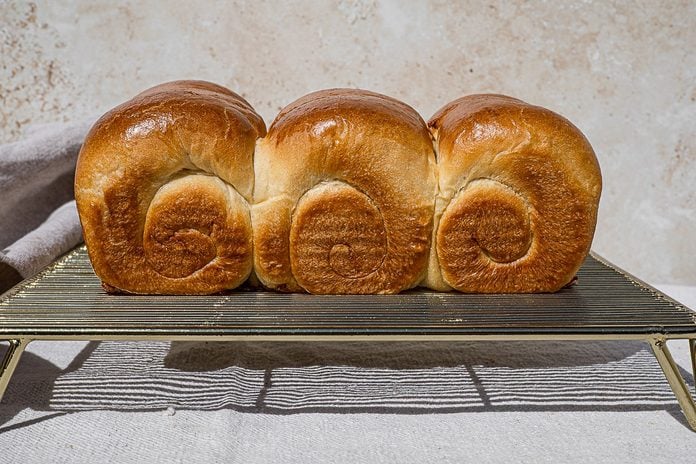
This Japanese milk bread recipe produces a loaf that's soft, fluffy and irresistible.
Ever wonder how Japanese bakers can produce such pillow-soft bread? Well, we’re sharing the secret in this Japanese milk bread recipe! It’s all about the tangzhong (roux starter) and a touch of patience. Plan to bake this bread when you have all day to relax.
What Is Japanese Milk Bread?
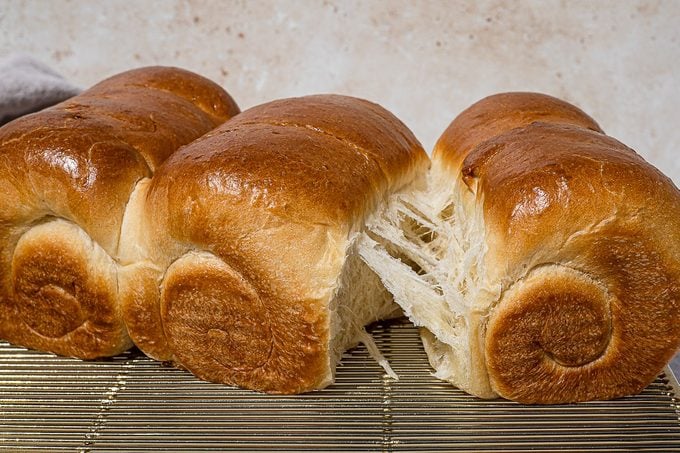
Japanese milk bread is a white bread with a fluffy interior and a distinct soft crust. The secret to its texture is the addition of tangzhong, a flour-based roux starter. The bread is also known as Hokkaido milk bread. However, the origins of that name are hard to trace. It could be because Hokkaido, a Japanese island, is renowned for its smooth, creamy milk.
What Is the Tangzhong Method?
Based on the Japanese dough starter method called yudane, the tangzhong method was popularized by Taiwanese cookbook author Yvonne Chen. This method makes a starter dough from a mixture of water, milk and flour. It’s then cooked until it becomes a smooth paste.
During this process, the starch from the flour is gelatinized via the high heat. The dough absorbs and locks in the moisture from the water and milk without activating any gluten. Tangzhong makes the bread more stable and keeps the bread moist for a longer period of time—and of course, it’s the key to softness.
Japanese Milk Bread Recipe
Ingredients
For the Tangzhong:
- 3 tablespoons water
- 3 tablespoons whole milk
- 2 tablespoons bread flour
For the Milk Bread:
- 275g bread flour
- 2 tablespoons milk powder
- 1 tablespoon superfine sugar
- 1 teaspoon salt
- 2 teaspoons active dry yeast
- 1/2 cup whole milk
- 2 tablespoons unsalted butter, softened
- 1 egg
- 1 tablespoon cold water
Editor’s tip: You can make superfine sugar at home by blitzing granulated sugar in a food processor. Learn more about types of sugar to see why superfine sugar is a must for this recipe.
Directions
Step 1: Make the tangzhong
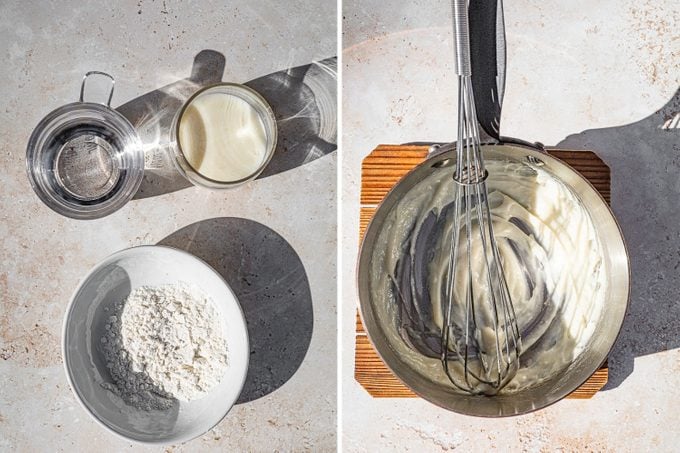
Place the water, milk and bread flour in a small pan. Mix until there are no lumps. It’s going to look very watery, but don’t worry, the heat will cook it down. Turn the heat to low. Stir the mixture constantly with a whisk for 3 to 5 minutes until it starts looking like glue, and the whisk leaves lines in the roux.
Transfer the tangzhong to a small bowl and leave to cool fully.
Step 2: Make the bread dough

In the bowl of a stand mixer, combine bread flour, milk powder, sugar, salt and yeast. Mix well. Then add in the milk, butter and tangzhong. Using the bread hook, combine the ingredients until you get a shaggy dough. Lightly knead for 2 minutes until the dough comes together.
Stop the mixer and let the dough rest for 15 minutes, covered with a clean kitchen towel. This helps the dough absorb the moisture and start the process of activating the gluten strands prior to kneading.
Put the bowl of dough back on the stand mixer and knead at medium speed for 15-20 minutes until the dough is soft and squishy.
Step 3: Let the dough rise
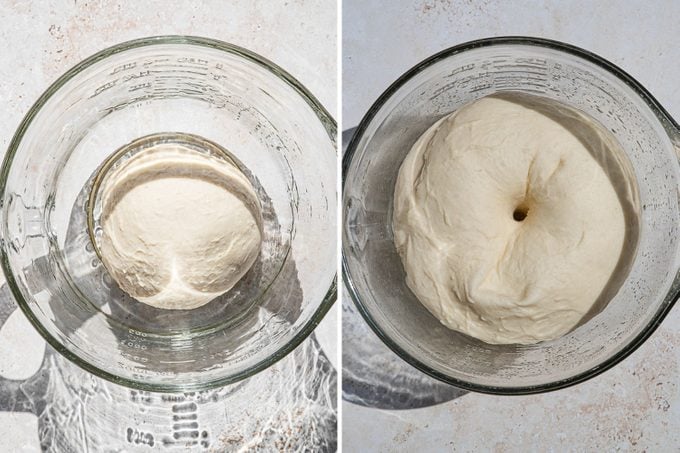
Lightly grease a bowl with vegetable oil. Form the dough into a tight ball and cover with cling wrap. Leave to rise in a warm area until the dough has doubled in size.
After an hour, it’s time to test if the dough is ready. Just flour one finger and poke the dough with it! If the hole stays and does not bounce back, the dough is ready.
Step 4: Divide the dough
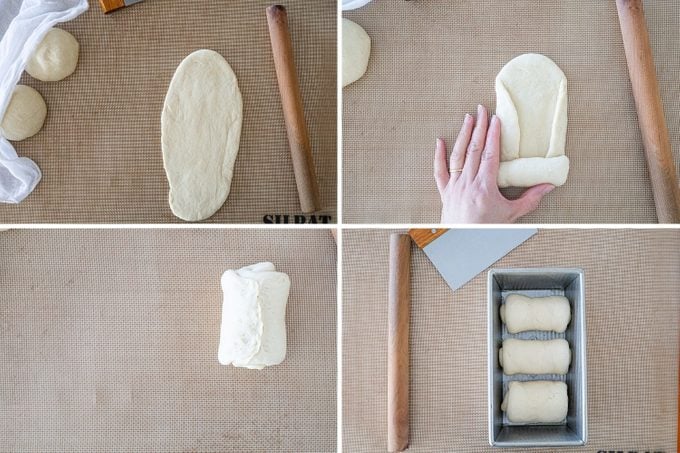
First, prepare a loaf tin by lightly greasing it with vegetable oil or melted butter.
Then punch down the dough and divide into 3 equal pieces. (You can use your kitchen scale to help with this.)
Roll each dough into a ball and cover with a damp cloth. Taking out only one ball at a time, roll the dough into an oval with a rolling pin, about 6 inches long.
Fold the outer curved edges into the middle, making long even lines on both sides.
Starting from the bottom, roll the dough into a tight ball. Pinch the seams to seal. Repeat with the rest of the dough. Place each rolled dough into the loaf tin.
Step 4: Let the dough rise again
Cover the tin with a damp cloth and leave to rise until the dough is close to the loaf tin height. It should take about an hour, but at the 30-minute mark, preheat your oven to 350°F.
Step 5: Prepare the egg wash
Make the egg wash by mixing together the egg and water. Once the dough has finished the second rise, brush the top of each loaf with the egg wash.
Step 6: Bake
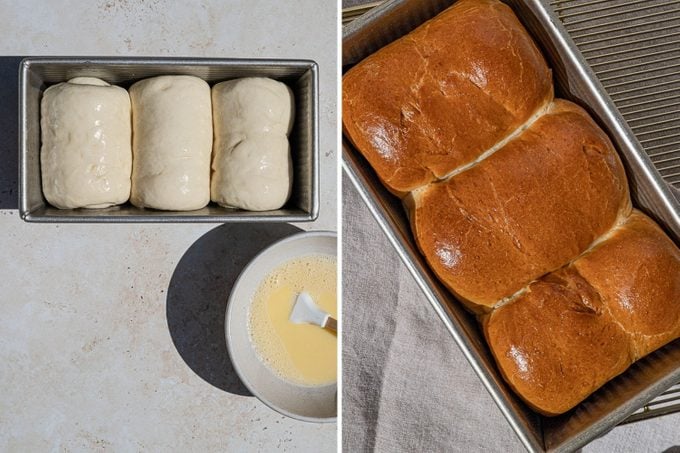
Bake the Japanese milk bread for 30 minutes. Let the bread cool in the tin for 10 minutes before transferring to a wire rack to cool completely.
I recommend waiting to slice the bread until it’s cool—this will seem impossible once the bread comes out of the oven, smelling warm and heavenly, but I promise it’s worth the wait!
Japanese Milk Bread Recipe Tips
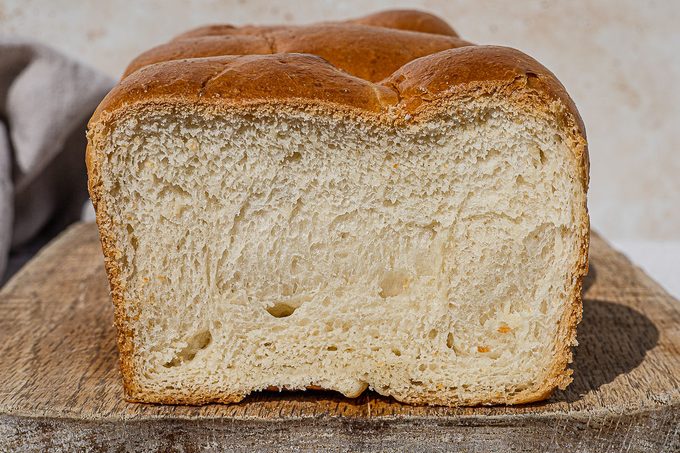
Is milk bread the same as brioche?
Brioche is an enriched bread that’s more dense and almost cakelike because it’s made with eggs and butter. On the other hand, milk bread is made with tangzong and the addition of milk powder. This gives the bread a milky flavor and a softer crumb.
How do I keep Japanese milk bread moist?
You really don’t need to do much, because the tangzhong will keep the bread moist just as long as you store it correctly. Just don’t put this bread in the refrigerator—the cold air affects the starches in a negative way and will make the bread go stale.
How do I store Japanese milk bread?
You can store the bread in an airtight container on your counter for up to a week. If you don’t think you’ll finish the bread in time, slice the bread and put in a freezer bag. It will stay fresh/frozen for up to 6 months. To defrost, just pop a frozen slice in the toaster.
What do you serve with Japanese milk bread?
It’s great lightly toasted with some homemade jam and butter. It’s also popular to have a slice of bread with egg salad.
Next up: Learn how to make fluffy Japanese pancakes from scratch.
